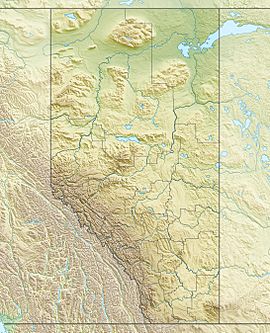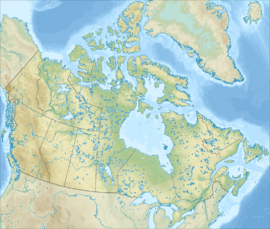Chak Peak facts for kids
Quick facts for kids Chak Peak |
|
|---|---|

Chak Peak seen from Cavell Meadows Trail
|
|
| Highest point | |
| Elevation | 2,775 m (9,104 ft) |
| Prominence | 235 m (771 ft) |
| Parent peak | Franchère Peak 2805 m |
| Listing | Mountains of Alberta |
| Geography | |
| Location | Jasper National Park Alberta, Canada |
| Parent range | Canadian Rockies |
| Topo map | NTS 83D/09 |
| Climbing | |
| First ascent | 1915 Topographical Survey |
Chak Peak is a tall mountain in Jasper National Park, Alberta, Canada. It stands about 2,775 meters (9,104 feet) high. This mountain is part of the amazing Canadian Rockies mountain range. It is located in the beautiful valley of the Athabasca River.
Contents
About Chak Peak
Chak Peak is a special mountain found in the heart of Jasper National Park. This park is a huge protected area in the Canadian province of Alberta. The mountain's highest point, called its summit, offers incredible views of the surrounding wilderness.
What Does "Chak" Mean?
The name "Chak" comes from the Stoney language. This language is spoken by the Stoney Nakoda First Nation people. In their language, "Chak" means "eagle." This name likely reflects the majestic eagles that might be seen flying around the mountain.
Where the Water Goes
Rain and melting snow from Chak Peak flow down its sides. This water, called surface runoff, travels into two creeks: Portal Creek and the Astoria River. Both of these are smaller rivers, known as tributaries, that eventually join the much larger Athabasca River. The Athabasca River is one of the most important rivers in Alberta.
Mountain Weather
Chak Peak has a type of weather called a subarctic climate. This means the winters are very cold and snowy. Temperatures can easily drop below -20 °C (which is -4 °F). When the wind blows, it can feel even colder, sometimes below -30 °C (-22 °F)! Summers are usually mild, not too hot.
How the Mountain Was Formed
Chak Peak is made up of different kinds of sedimentary rock. This rock formed over millions of years, from the Precambrian to the Jurassic periods. Imagine layers of sand, mud, and tiny bits of ancient sea creatures piling up and turning into rock.
Later, a huge event called the Laramide orogeny happened. This was a time when massive forces deep within the Earth pushed and folded the land. These forces lifted the older rock layers of Chak Peak up and over younger rock. This is how the mountain we see today was created!



